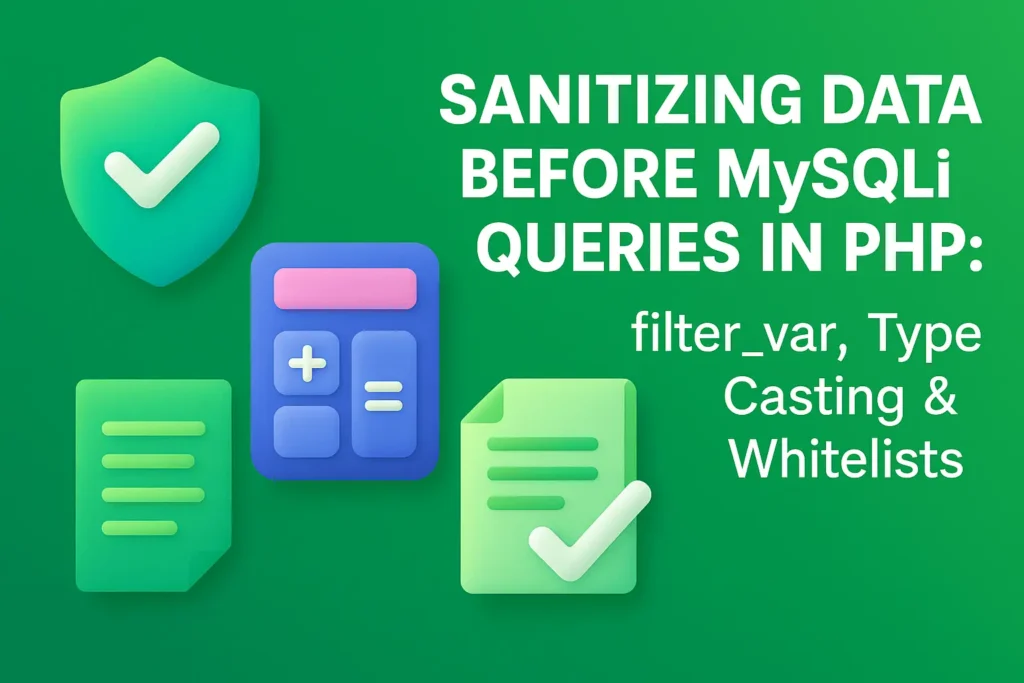Why Data Sanitization is Important
- Security: Sanitizing data prevents SQL Injection attacks, which can exploit unsanitized user input to execute malicious SQL commands.
- Data Integrity: Ensures that data stored in the database is clean, consistent, and adheres to expected formats.
- Application Stability: Helps prevent errors and crashes by ensuring that only valid data is processed.
Key Techniques for Data Sanitization
1. Using Prepared Statements
Prepared statements are a powerful method for sanitizing data. They separate SQL code from data, preventing malicious data from being executed as SQL commands. This technique is particularly effective for preventing SQL Injection attacks.Example of Prepared Statements with MySQLi:
<?php
$mysqli = new mysqli("localhost", "user", "password", "database");
if ($mysqli->connect_error) {
die("Connection failed: " . $mysqli->connect_error);
}
// Prepare the SQL statement with placeholders
$stmt = $mysqli->prepare("SELECT * FROM users WHERE username = ? AND email = ?");
// Check if the statement was prepared successfully
if ($stmt === false) {
die("Prepare failed: " . $mysqli->error);
}
// Bind the parameters to the query
$stmt->bind_param("ss", $_POST['username'], $_POST['email']);
// Execute the statement
$stmt->execute();
// Get the result
$result = $stmt->get_result();
if ($result->num_rows > 0) {
echo "User found!";
} else {
echo "No user found.";
}
// Close the statement and connection
$stmt->close();
$mysqli->close();
?>
2. Escaping Special Characters
Escaping special characters is another technique to sanitize data. It involves adding a backslash before special characters to prevent them from being interpreted as part of the SQL syntax. MySQLi provides the real_escape_string method for this purpose.Example of Escaping Special Characters:
<?php
$mysqli = new mysqli("localhost", "user", "password", "database");
if ($mysqli->connect_error) {
die("Connection failed: " . $mysqli->connect_error);
}
// Get and sanitize user input
$username = $mysqli->real_escape_string($_POST['username']);
$email = $mysqli->real_escape_string($_POST['email']);
// Construct the SQL query
$sql = "SELECT * FROM users WHERE username = '$username' AND email = '$email'";
// Execute the query
$result = $mysqli->query($sql);
if ($result->num_rows > 0) {
echo "User found!";
} else {
echo "No user found.";
}
$mysqli->close();
?>
3. Validating Input Data
Validation involves checking that the input data conforms to expected formats, types, and constraints. While validation alone does not sanitize data, it ensures that only properly formatted data is processed.Example of InputValidation:
<?php
$username = $_POST['username'];
$email = $_POST['email'];
// Validate username (alphanumeric and length between 3 and 20 characters)
if (preg_match("/^[a-zA-Z0-9]{3,20}$/", $username) && filter_var($email, FILTER_VALIDATE_EMAIL)) {
echo "Input is valid.";
} else {
echo "Invalid input.";
}
?>
In this example, preg_match checks that the username contains only alphanumeric characters and is within the specified length, while filter_var ensures that the email address is in a valid format.
4. Type Casting and Filtering
Type casting and filtering involve converting input data to the appropriate type and removing any unwanted characters or content. PHP provides various functions for type casting and filtering.
Example of Type Casting and Filtering:
<?php
$age = $_POST['age'];
$age = filter_var($age, FILTER_VALIDATE_INT);
if ($age !== false && $age >= 0 && $age <= 120) {
echo "Valid age.";
} else {
echo "Invalid age.";
}
?>
5. Removing HTML and PHP Tags
To prevent Cross-Site Scripting (XSS) attacks and ensure that user input does not include malicious code, it is important to remove HTML and PHP tags from the input.Example of Removing HTML and PHP Tags:
<?php
$comment = $_POST['comment'];
$comment = strip_tags($comment);
echo "Sanitized comment: " . $comment;
?>
Combining Sanitization Techniques
For comprehensive data sanitization, it is often necessary to combine multiple techniques. For example, you might use prepared statements for SQL queries, validate and sanitize input data, and remove HTML tags:Example of Combined Sanitization:
<?php
$mysqli = new mysqli("localhost", "user", "password", "database");
if ($mysqli->connect_error) {
die("Connection failed: " . $mysqli->connect_error);
}
// Get and sanitize user input
$username = strip_tags($_POST['username']);
$email = strip_tags($_POST['email']);
$username = $mysqli->real_escape_string($username);
$email = $mysqli->real_escape_string($email);
// Validate input
if (preg_match("/^[a-zA-Z0-9]{3,20}$/", $username) && filter_var($email, FILTER_VALIDATE_EMAIL)) {
// Prepare the SQL statement
$stmt = $mysqli->prepare("SELECT * FROM users WHERE username = ? AND email = ?");
if ($stmt === false) {
die("Prepare failed: " . $mysqli->error);
}
// Bind the parameters and execute the statement
$stmt->bind_param("ss", $username, $email);
$stmt->execute();
$result = $stmt->get_result();
if ($result->num_rows > 0) {
echo "User found!";
} else {
echo "No user found.";
}
$stmt->close();
} else {
echo "Invalid input.";
}
$mysqli->close();
?>
Best Practices for Data Sanitization
- Use Prepared Statements: Always use prepared statements with parameterized queries to prevent SQL Injection.
- Validate and Sanitize Input: Combine validation and sanitization to ensure input data is both accurate and safe.
- Avoid Direct SQL Query Construction: Never directly include user input in SQL queries without sanitization.
- Escape Special Characters: Use appropriate escaping functions when direct SQL construction is necessary.
- Regularly Review and Update: Regularly review and update sanitization practices to address new security threats and vulnerabilities.
Conclusion
Sanitizing data before executing queries is essential for maintaining the security and integrity of web applications. By employing techniques such as prepared statements, escaping special characters, validating input, type casting, and removing HTML tags, you can safeguard against SQL Injection attacks, data corruption, and other security issues. Combining these techniques and following best practices will help ensure that user inputs are clean, valid, and secure, contributing to a robust and reliable application.






